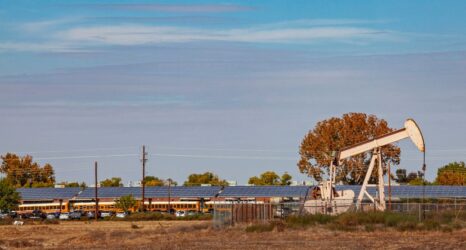This post is part of a series of Ms. reports on the blog and in print that look at the organizing models of some of the women-led groups helping to build a sustainable grassroots movement to boost renewables and combat climate changes. The series will end with an interactive online webinar and briefing with leaders from Mothers Out Front and Ohio Valley Environmental Coalition to empower readers who want to advocate for renewables in their communities. RSVP today!
For seven years, starting in 2003, Kris Mayes served on the Arizona Corporation Commission, the state’s Public Utilities Commission, including as its chair. During that time many states were adopting renewable portfolio standards, regulations that require increased energy production from renewable energy sources. Mayes helped co-author Arizona’s standard, which mandates that utilities get 15 percent of their power from renewable sources like wind, solar and geothermal by 2025.
“Because we adopted that renewable energy standard, as well as the nation’s best net metering policy, Arizona boasts more than 10,000 solar jobs and can legitimately call itself a leader in solar energy,” says Mayes, who’s now a professor of utility law and policy at Arizona State University’s School of Sustainability.
As women-led groups across the U.S. help grow a sustainable grassroots movement pushing renewable energy as one way to combat climate change, female leaders like Mayes are using their decision-making power to also speed up this shift of our energy system to one that’s more localized, cleaner and less dependent on greenhouse gas-producing fossil fuels.
About 15 percent of the electricity generated in the U.S. last year was from renewable energy sources, according to the U.S. Energy Information Administration. The majority of electricity generation still comes from fossil fuels like oil, coal and natural gas, about 65 percent, but the use of renewables is rising. Renewable fuels had the largest increase in energy consumption of all the fuels in 2016, while coal consumption continues to fall.
Renewable portfolio standards, which more than half the states in the U.S. now have, may be one factor in helping spur this change. Another potential factor? Women in the industry.
“Evidence from many sectors suggests that integrating women into all levels of the energy value chain will lead to more effective clean energy initiatives, unleash greater return on investments and expand emission reduction opportunities,” says Lorena Aguilar, the International Union for Conservation of Nature’s global senior gender adviser.
Gender-disaggregated data in the renewable energy sector is scarce, but some studies indicate it may attract more women. A survey by the International Renewable Energy Association of nearly 90 private renewable energy companies from more than 40 countries, for example, found that women represent an average 35 percent of the workforce. This is a significant finding, the study says, considering women make up 20 to 25 percent of the workforce in the overall energy industry.
Despite that, Aguilar says women are still lacking from high-level decision-making positions in the energy sector. Those interviewed point to a range of things that could help change this, from mentoring young women, improved networking and the right messaging to better data and encouraging more women to enter politics and a broader range of renewable-related fields.
“Although my own undergraduate education was in electrical engineering, that’s not a requirement to get into this field,” says Suzanne Bertin, executive director of the Texas Advanced Energy Business Alliance. “Young women have plenty of other job opportunities in energy, including construction, project management, software development, data analytics, sales, marketing, finance, public affairs and media relations, as well as the government policy work like I do. Perhaps many women don’t think of pursuing careers in energy because they do not know about all of these fantastic options that are available.”
In addition to having more women in the energy sector, these female industry leaders say groups on the ground may want to consider certain strategies to make their renewable energy work even more effective than it’s already been.
“Pointing out the role that renewable energy plays in creating a more inclusive economy is particularly important for local groups to focus on,” says Nancy Pfund, founder and managing partner of DBL Partners, a venture capital company that invests for both strong financial and social returns, including in new clean energy companies. “Job creation, especially jobs that bring diverse employees into the workforce, equates to compelling political capital that can be used to advance the goals of these organizations.”
Bertin agrees, saying they’ve found that showing the economic and market impacts helps promote renewables. Other approaches, she adds, include telling policymakers compelling stories about how individuals are benefitting from these new technologies and putting a human face on the desired policy outcome.
“Of course, voters also need to vote for policymakers that support renewable energy, energy efficiency and other technologies that make the electric grid better,” she says. “Supporters of advanced energy should push for policies that remove market barriers, encourage innovation and diverse energy sources, modernize our electric grid and offer customers choices and access to renewable sources.”
Holding policymakers accountable for decisions that their constituents support is also key, says Mayes. So is embracing a broad group of partners in the movement.
“The most effective strategies are those that… bring together a diverse coalition of voices to show support for clean energy,” says Mayes, who is a Republican. “For instance, there are plenty of conservative organizations and individuals who represent millions of Americans in deep red states like Arizona who support clean energy, and in particular the right to produce your own energy through technologies like solar. There is also a groundswell of businesses that want to use clean energy and promote it. We need to make sure that policymakers understand the depth of support for clean energy.”
This story has been supported by the Solutions Journalism Network, a nonprofit organization dedicated to rigorous and compelling reporting about responses to social problems.





